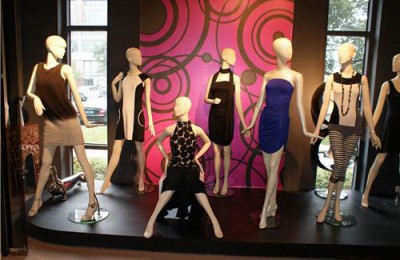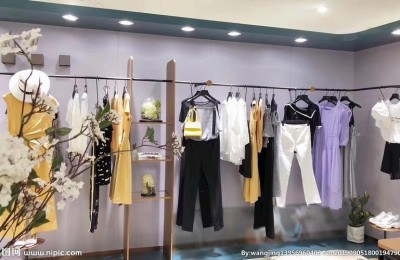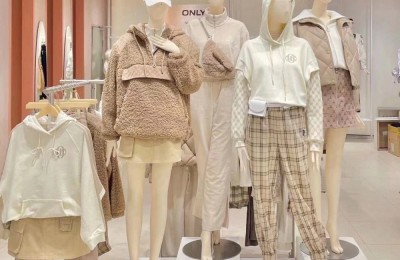32. What are the style characteristics of traditional varieties of worsted woolen fabrics?
Answer: The style characteristics of traditional varieties of worsted woolen fabrics are described below.
(1) Serge: Serge is the transliteration of serce. Serge is divided into fine noodles, and there are two types: finished noodles and cashmere noodles. The finishing process of serge is required. Depending on the unit weight, serge can be divided into three types: thick serge, medium-thick serge and thin serge. Thin serge has a light and soft body and is very suitable for women and children’s work wear. The style characteristics of serge are that the twill grain on the surface of the fabric is relatively wide and flat, the grain is not protruding, the twill angle is about 45°, the weft-to-warp density ratio is about 0.86, the weave is 2/2 right-skew, and some thick serges also use 3/3 Right slanted.
(2) Gabardine: also known as gabardine, because gabardine is often treated with water-blocking finishing and used as a fabric for rain or shine coats, so it is a translation. In the past, it was customary in business to call the warp and weft gabardine, and the warp and weft gabardine. The weave is generally 2/2 right diagonal, and the twill is a sharp twill with an angle of 62°-63°. The twill surface has clear and raised thick stripes with warp as the main body. Its latitude-longitude ratio is around 0.50 to 0.52. Gabardine comes in three specifications: medium-thick, medium-thin and thick. Medium-thick gabardine, referred to as gabardine, requires thick and straight surface grain, tight warp and weft yarn structure, and thick body bones. It is the representative variety of gabardine. Medium-thin gabardine, also known as single-sided gabardine, has a 2/1 right-hand bias weave. The surface of the gabardine shows fine and clear sharp twill lines. The body is solid and thin. Because it is a 2/1 right-hand bias weave, the reverse side of the fabric has unobvious wefts. Face twill, this is the origin of single-face gabardine. The product is light in weight, the fabric is fine, clean and elegant, and has good drape. Thick and heavy gabardine is also called satin back gabardine. Its structure is satin back weave (a type of reinforced satin weave). The front side of the fabric is similar to 2/sharp twill, and the back side is satin weave, similar to a double-layer weave. The twill inclination angle is 56°-57°, and the weft-to-warp density ratio is 0.45-0.50. The fabric has full body bones and good warmth retention.
(3) Hailimeng: It is the transliteration of harring bone, and it is the same type of product as serge. However, the weave adopts 2/2 right-hand twill or 3/3 right-hand twill, the complete number of warp threads is 8×2 or 12×2, and Kj is 8 or 12 (K is the number of warp threads before the twill direction is changed). The surface is in the shape of a herringbone strip with horizontal wavy patterns, which is the style characteristic of Hailimeng. The weft-warp density ratio is about 0.8, the color is mainly darker plain, and the body bones are slightly thicker than serge. It is a higher-grade product than serge.
(4) What flavor is it? It is the transliteration of worsted flannel. Because the product is made of woolen noodles, it is called it. It is the same type as serge. The main difference between serge and serge is that serge is plain color and the fabric is rough and thick. , what kind of flannel is mixed color, the fabric is fine, clean and tight, and the finishing after shrinking is similar to that of woolen flannel, so it is also called worsted flannel. The color is mainly gray with various variegated colors. The color mixing method is generally to mix white wool strips and colored wool strips to form various dark, medium and light colors. The best quality is to mix colors very uniformly, so it is generally mixed with intermediate colors between dark and light contrasting colors. , to soften the strong perception of contrasting colors and form a uniform color mixing phenomenon. Printed tops are also used to mix colors. This color mixing effect is uniform, but the color mixing on the wool surface seems to be an absolutely uniform color mixing style, which is another style different from the color mixing of colored tops. The fabric structure is the same as that of serge, and the weft-warp density ratio is about 0.8 to 0.85. The texture of the fabric is soft, and due to the different thickness and lightness of the hair on the fabric, it can be divided into five different styles: full fabric, front fabric, sub-fabric, high-fabric and low-fabric.
(5) Fanzhanding: The transliteration of valitin is a summer fabric variety among worsted wool products. It adopts a plain weave, and is also woven with forward and reverse twisted yarns to form hidden stripes and hidden grid patterns. But this does not belong to the authentic Fanzhanding. Fanzhan Ding’s style is characterized by clear, bright and natural plain grains on the surface. The fabric is light and crisp, smooth and flexible, the surface is smooth and fine, and the warp and weft density is relatively tight. The weft-warp density ratio is between 0.88 and 0.90, and thin and high-twist yarns are often used. Due to the different yarn characteristics, the fabrics are divided into two types: thick and thin.
(6) Palis: Transliteration of palace, it is a summer fabric of worsted products, and is also a thin variety of worsted woolen fabrics. The distinctive feature of this fabric is that the woolen surface has darker wool fibers than the main color. It is unevenly distributed on the surface of the cloth, causing the surface to form faintly visible stripes composed of rain-like criss-crossing stripes of dark and light colors. The reason for the formation of this style is that the original color of wool and the main color are used as the base color, and fibers darker than the main color are used as the visible color. Some auxiliary colors can also be mixed in to increase the vividness of the color. If the main color is gray, the auxiliary color can be dark blue or light green. Generally, white wool accounts for 60% to 70%, the main color accounts for 20% to 25%, and the visible color accounts for 5% to 8%. The proportion of the main color can be adjusted according to the color finish requirements, but the amount of visible color cannot be increased, otherwise it will affect the style. The main color can be corrected with two similar shades. But you can’t use intermediate colors.
Palis is generally a plain weave, and the weft-to-warp density ratio is generally 0.8 to 0.82. The warp yarn is a strand, and the weft yarn is a single yarn. It feels smooth, stiff, thin, flexible, elastic, and has different colors. Clearly, the surface is flat, clean, quiet, and natural.
(7) Women’s clothing: This variety has many designs and colors, and the color is brighter.It is bright and changes with fashionable colors. The weave includes plain weave, variable twill, jacquard, crepe, etc. It also has different patterns such as plain color, stripes, decorative flowers, and printing. The warp and weft yarns are both strands, or the warp is strands and the weft is single yarn, and the texture of the fabric is relatively loose, soft and light.
(8) Tweed: It is the main variety of worsted woolen fabrics and the mainstream variety in woolen fabric sales. It is made of various shades of colored yarns, mixed-color yarns and double roving yarns combined into same-color or different-color yarns. There are also one thick special yarn and one thin special yarn made into strands, and there are also three-ply lines. , coupled with the ever-changing pattern structure, forming a variety of woolen fabrics with many changes in patterns and colors. It can adapt to the needs of different seasons in spring, summer, autumn and winter. And can meet consumer requirements through continuous innovation. From the appearance style and characteristics of the fabric, it can be divided into: plain tweed, striped tweed, thick plain tweed, thin tweed, diamond tweed, sawtooth tweed, birds eye tweed, cashmere tweed, etc.
(9) Bansi: It is the transliteration of basket. It is a traditional variety of plain medium-thick fine fabrics. The commonly used weave is 2/2 square, with a weft-to-warp density ratio of 0.85 to 0.88. There are two varieties: solid color and mixed color. A/B floral thread (a pattern thread in which yarns of two different colors are combined and twisted) is commonly used. The noodles show the style characteristics of small squares, and the body bones are dense and thick.
(10) Single-sided tweed: A double-warp weave that adopts warp layering. It is named after the different patterns on the front and back sides. Colored inserts and jacquard inserts are generally used to weave different stripes or patterns on the front and back sides. , and uses the left and right twist directions of the spinning yarn to weave hidden stripes as narrow as the width of a toothpick, so it is called toothpick tweed. The characteristics of the fabric are that the body is tight and thick, the hand feels smooth and waxy, the surface shows hidden stripes, it is stable and generous, and the front and back have different patterns. It is a high-end representative variety among worsted products. The weft/longitude density ratio is between 0.64 and 0.70.
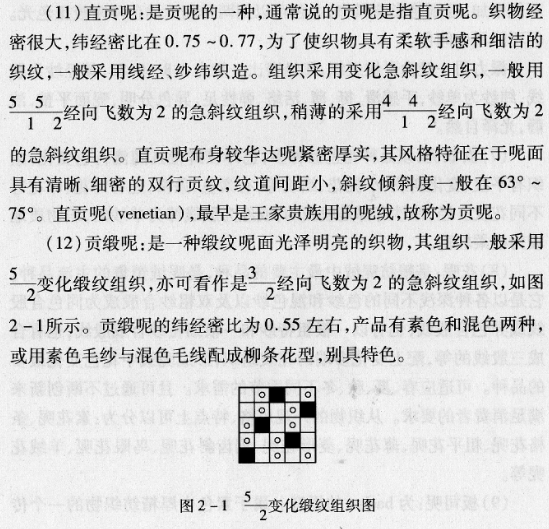
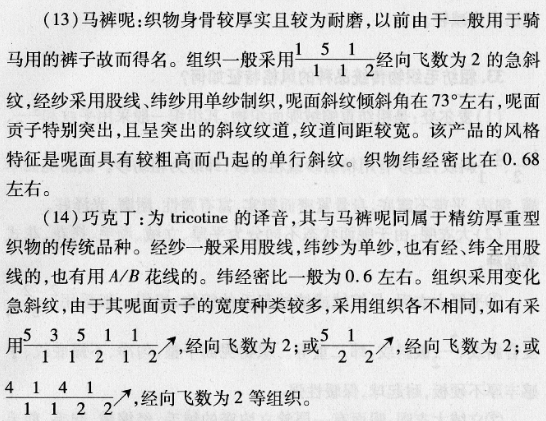
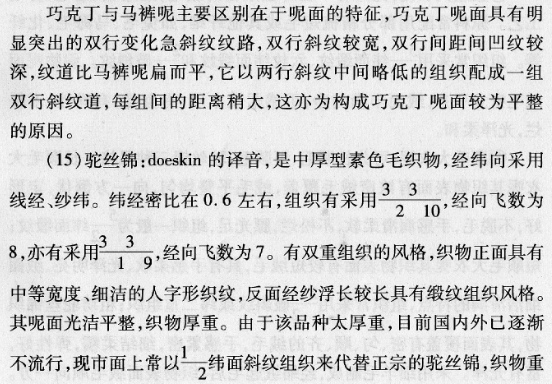
The amount is greatly reduced.
AAAFGHTYHCGER
Disclaimer:
Disclaimer: Some of the texts, pictures, audios, and videos of some articles published on this site are from the Internet and do not represent the views of this site. The copyrights belong to the original authors. If you find that the information reproduced on this website infringes upon your rights, please contact us and we will change or delete it as soon as possible.
AA



